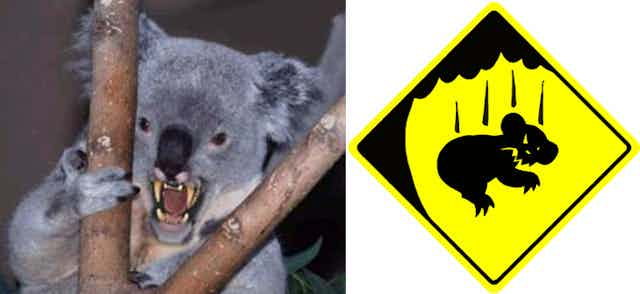Drop bears (Thylarctos plummetus) are a species of carnivorous Australian marsupial, renowned for preying on tourists in the bush. Infamous for their mode of attack, new technology is now shedding light on their distribution, population and behaviour.
Drop bears spend most of their time in treetops. They hunt by ambushing ground-dwelling animals (mainly medium to large mammals) from above, skilfully latching onto the victim’s neck to kill the prey. Quietly waiting in a tree for several hours, the drop bear closely resembles a sleeping koala.
Once prey is within striking range, the drop bear will plummet several metres out of the tree to pounce on top of the unsuspecting victim. The initial impact generally stuns the prey, allowing it to be bitten on the neck and quickly subdued.
Look out above
Bushwalkers are prone to come in contact with drop bears when hiking off the beaten track in Australia. Thanks to a new approach to animal tracking, it is now possible to minimise attacks on humans and enhance conservation practises in these areas.
Drop bears do not specifically target human beings. Yet there have been several cases where humans have fallen victim to drop bear attacks, resulting in serious lacerations and even death. Numerous disappearances may also be attributed to drop bears.
While the Australian government has been accused of orchestrating a conspiracy to cover up the existence of drop bears in order to protect the tourist industry, these claims have never been substantiated.
Animal tracking goes high-tech
For about 50 years, the tagging and tracking of animals has been a vital tool to better understand animal behaviour and ecology.
The introduction of satellite-based positioning technology into the field of animal tracking has made a huge impact. It has opened the door to many exciting discoveries and heavily supports animal conservation efforts.
Global Positioning System (GPS) and other Global Navigation Satellite System (GNSS) signals can provide accurate, regular and frequent estimates of the changing distributions of many rare animal species. This means that it is possible to determine animal positions continuously rather than relying on occasional snapshots of the animal’s whereabouts.
Conventional GNSS-based tracking methods require the sensor to be directly attached to the animal of interest. This makes it extremely difficult to study tree-dwelling animals like the drop bear. The dense tree canopy regularly causes extended periods of complete GNSS signal loss, and sensors are often damaged during attacks on prey. This severely reduces the availability of meaningful tracking data and substantially increases the cost of drop bear tracking.
Tracking drop bears, the student method
To address these shortcomings, an alternative for tracking drop bears has recently been proposed in the Australian Geographer. This indirect GNSS-based method involves tracking the prey rather than the predator. The animal population is then mapped by pinpointing the location and timing of drop bear attacks.
It has been demonstrated that this method can effectively estimate the number and distribution of drop bears in a particular area. The analysis has also given valuable insights into the animal’s hunting behaviour.
The study has confirmed that foreigners are much more likely to be “dropped on” than Australians. The results also indicate that drop bears do not necessarily target the last person walking in a line.
Obviously, a better understanding of drop bear behaviour and ecology allows us to ensure that a sustainable population is maintained, while the possibility of attacks on humans is limited. The indirect GNSS-based tracking method provides us with a tool to do just that.

